The left and right side of the brain are involved in different tasks. This functional lateralization and associated brain asymmetry are well documented in humans, but little is known about brain asymmetry in our closest living relatives, the great apes. Using endocasts (imprints of the brain on cranial bones), Philipp Mitteroecker of the University of Vienna together with scientists of Max-Planck-Institute in Leipzig now challenge the long-held notion that the human pattern of brain asymmetry is unique. They found the same asymmetry pattern in chimpanzees, gorillas, and orangutans. However, humans had the largest variability of this pattern. This suggests that lateralized, uniquely human cognitive abilities, such as language, evolved by adapting a presumably ancestral asymmetry pattern. [read more]
Simon Neubauer, Philipp Gunz, Nadia A. Scott, Jean-Jacques Hublin, Philipp Mitteroecker: Evolution of brain lateralization: a shared hominid pattern of endocranial asymmetry is much more variable in humans than in great apes. Science Advances 6, eaax9935 (2020). DOI: 10.1126/sciadv.aax9935

